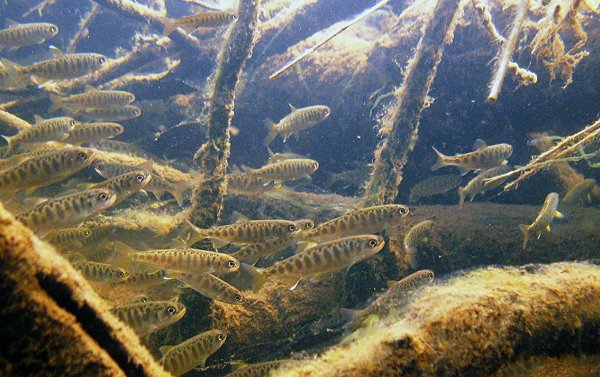Along the Oregon coast, seven ODFW hatcheries propagate fall-run Chinook salmon for release into the Lower Columbia, Nestucca, Trask, Salmon, Lower Umpqua, Elk, Coos, Coquille, and Chetco rivers. These hatchery programs are operated almost entirely for the purpose of harvest augmentation, except for a recently established conservation hatchery program for Coquille River fall Chinook. Given increasing river temperatures, more variable flow regimes, and changing ocean conditions, existing release strategies may not be sufficient or cost-effective as conditions change. The goal of this study is to examine rearing and release strategies for juvenile hatchery Chinook salmon and identify those that optimize the quality and abundance of returning adult salmon, carried out under current climatic conditions and with existing hatchery infrastructure. To achieve this goal, researchers will collaborate with ODFW to evaluate the performance of existing and novel release groups of Chinook salmon.
Timing of Release
(2022 - present)
-
-

Dr. Jessica Miller
Principal Investigator
Professor at Oregon State University
-
Other Contributors
Dr. Brian Beckman (NOAA), Dr. Marc Johnson (NOAA), Nick Strait (OSU)
Methods
In 2024, we completed two experimental releases of 2023 brood year fall Chinook salmon, which included new tagged release groups (30,000 in each group) in the Trask and Coos hatchery systems. Trask River releases occurred by June 12, 2025, at approximately 50 fish per pound, which is a bit earlier and larger than originally proposed but still provides a comparison for the existing August, in-river volitional release of fish (19 to 30 fish per pound). The Coos Bay releases proceeded as planned with the new release of 30,000 CWT fish reared at Cole Rivers and released at Morgan Creek in June between 60 to 90 fish per pound. The other, existing release groups (all with 30,000 CWT) included the first Morgan Creek volitional release, which occurred during last two weeks of May at ~60 fish per pound. Additionally, on June 12, Noble Creek was opened for volitional release of fish at ~55 fish per pound. In mid-June, Cole Rivers fish were transported to Morgan Creek for their October release.
Additionally, we completed pre-release sampling of juvenile body size and condition. At least fifty individuals were weighed and imaged in May 2024 from the Morgan Creek STEP June release, Millicoma STEP mid-May release into Fourth Creek, and the later Morgan Creek STEP release group that was still in Bandon Hatchery. We also sampled the wild Coquille experimental release group (Coquille Wild Double Indexed Fish) that was begin reared at the Bandon hatchery for comparison with the other release groups.
The experiment takes place at 5 systems in Oregon:
Klaskanine Salmon Hatchery (pictured)
Bandon Fish Hatchery and other Coos R hatcheries
Plans for 2025
For the 2025 release groups, we will repeat the Trask and Coos releases, which will be similar to last year. Additionally, discussions with ODFW identified a research need within the Umpqua River Rock Creek hatchery system, which releases Spring Chinook salmon (55H stock). Their current production includes two release groups: 1) 150,000 smolts at 8 to 10 fish per pound to be released in the North Fork Umpqua River in late September to early October and 2) 192,000 smolts at 6 to 8 fish per pound for release into the North Fork Umpqua River in early February. These two groups receive CWTs and fin clips (50,000 CWT per group) prior to release. The fish for the fall release are reared at Cole Rivers and transferred to the Rock Creek hatchery in the fall shortly before release. There is interest in receiving these fish at Rock Creek earlier in the year to better align release timing with in-river water quality conditions. The Rock Creek hatchery has expanded its capacity to pump water and now have a back-up generator, which creates an opportunity to evaluate this option. Therefore, the fish will be transferred from Cole Rivers to Rock Creek hatchery by September 1, 2025, and this fall release group will now be split into two releases, including an “earlier” release and the existing late September to early October and each group will have 50,000 CWTs and fin-clips. This additional tag group will allow for an evaluation of survival across the three release groups (early fall, mid-fall, and spring).
Management Implications
This research is expected to generate actionable recommendations for juvenile salmon rearing and release strategies by quantitatively comparing existing and new release groups. Given the duration of marine residence and the variable age-at-maturity for coastal Chinook salmon populations, full analysis of survival data will take several years. Overall, the knowledge generated can inform hatchery practices and, potentially, also identify infrastructure needs that facilitate the development of more resilient hatchery rearing strategies considering projected future environmental variation.
USFWS Flickr



